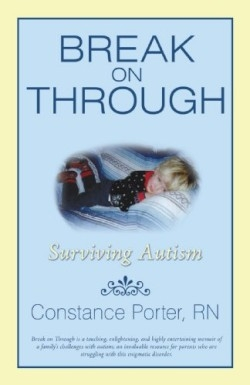Break on Through
Autism is diagnosed in one out of 150 children. Since it is a lifelong disability families must cope not only with the day-to-day challenges of autism but they must also make plans for providing a lifetime of care.
In Break on Through Constance Porter gives an achingly real account of what it is like to live with and care for Derek her autistic son. Porter is also a nurse and her medical insights offer another perspective on the disorder.
Porter tells the story of how her son wanted to visit some neighbors who had been friendly to him in the past. He didn’t know that they had moved. He also didn’t understand that in the winter you should always wear shoes. Their new neighbor made a call to 911 saying “…there’s a guy on my property… There’s a foot of snow on the ground and he’s barefoot… He must be on crack or something…”
His mom had to provide proof to the cops that he was in fact not a drug addled criminal but “…a nonverbal twelve-year-old autistic kid who has no idea what breaking and entering is.” Fortunately because he didn’t fully understand the situation Derek took his being handcuffed and put in a police cruiser better than his poor mother.
Diffusing tricky sometimes dangerous situations like this is something the author has had to do more than once. Despite nearly constant supervision her son doesn’t understand social cues and danger the way neurotypical people do.
Autism affects every member of the family differently. The book includes essays from Derek’s father and siblings that outline their perspectives on how autism has affected their lives.
Rex Derek’s father is a physician and he had some experience with children with autism while in medical school. After Derek’s diagnosis he describes how he felt: “All of the hopes and aspirations you have for your child vanish in an instant… Your son has ‘died’ and yet there is still this little alien before you…”
Porter does a great job of highlighting the many confusing and dangerous situations that can arise out of the most ordinary circumstances when they include an individual with autism. Her vivid recollections paint a picture for those who don’t know what it’s like to be in her situation. Those same memories create a bond with readers who have cared for a loved one with autism.
The author outlines her experiences with many therapies and treatments in an honest and informative way but she is a bit harsh on those that she personally doesn’t agree with.
With autism affecting so many individuals and their loved ones many people will find this book interesting because of autism’s personal meaning to them. It gives a human face and experience to a confusing disorder that is often misunderstood.
Reviewed by
Laura Munion
Disclosure: This article is not an endorsement, but a review. The publisher of this book provided free copies of the book and paid a small fee to have their book reviewed by a professional reviewer. Foreword Reviews and Clarion Reviews make no guarantee that the publisher will receive a positive review. Foreword Magazine, Inc. is disclosing this in accordance with the Federal Trade Commission’s 16 CFR, Part 255.

